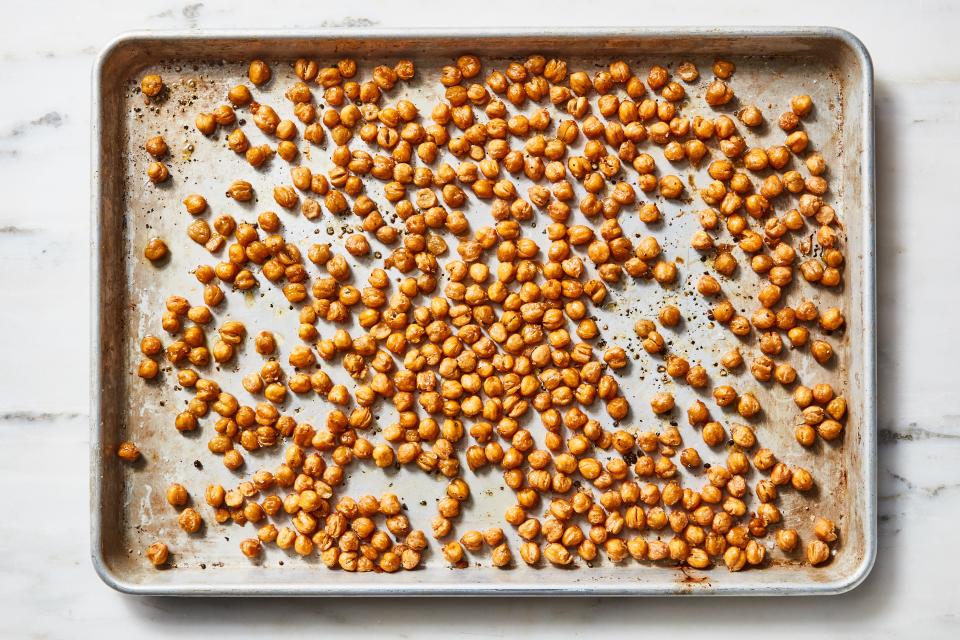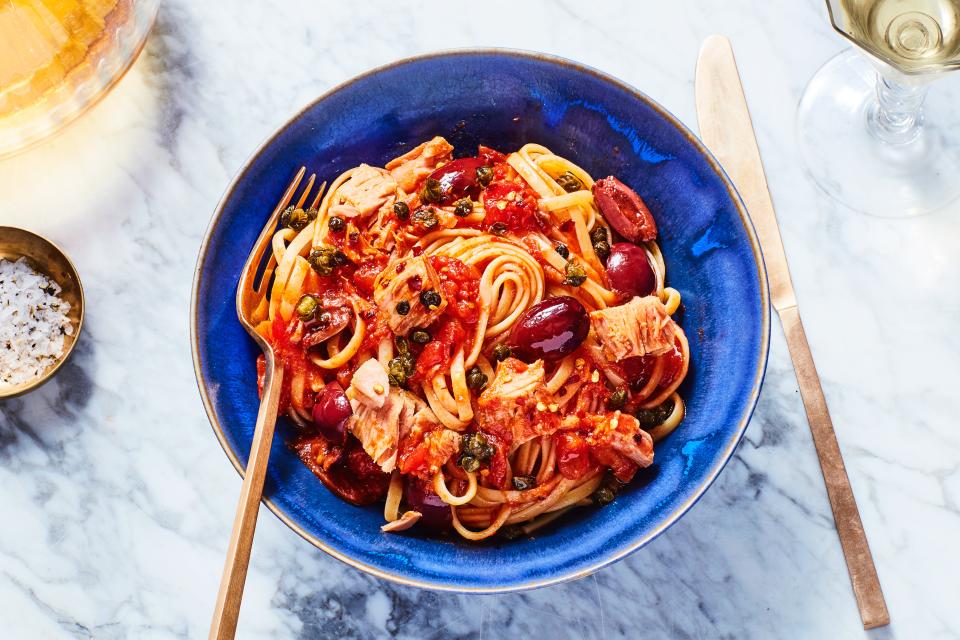How to Stock Your Kitchen for the Coronavirus Era (and Other Emergencies)
As a new coronavirus (SARS-Cov-2) spreads across the world and government officials warn that things may get worse before they get better, it’s only natural that our minds will race. We worry about getting sick, and about our family getting sick, and about that guy sitting next to us on the bus getting sick.
Coming down with the disease the virus spreads (COVID-19) is just part of it. Around the world, those who have caught the virus, as well as people who have simply been around people who have the virus, have been asked to take social distancing measures. Sometimes that means working from home; sometimes it means going into isolation for 14 days.
Last week, officials from the CDC told Americans to expect further breakouts of COVID-19, a warning that turned out to have merit. With more cases expected, some form of social distancing is probably coming for a lot of us. And while there are myriad implications of staying indoors for days at a time, we’re naturally thinking about the issues related to food and cooking.
Should we all be stockpiling a 14-day supply of food? If we are asked to stay at home for a period of time, how should we ration our food? How do we make sure that we can feed ourselves for a couple of weeks without going to the grocery store, but not go overboard and end up with two hundred cans of chickpeas? This guide aims to help answer these questions.
But first, let’s be clear: as of this writing there are around 100 reported cases of COVID-19 in the United States, and one recent study suggests that 80 percent of all COVID-19 cases are mild. So please don’t let this guide put you into a panic; instead, let it be a resource—one that, hopefully, you won’t have to use.
For up-to-date information about the coronavirus, refer to the CDC’s coronavirus page. (One thing the CDC will always tell you: keep washing your hands!)
For information about preparing your pantry for coronavirus isolation (or other emergencies), keep scrolling.
First things first: Should we all be stockpiling food?

“Stockpiling” may be a dramatic way to put it. However, the government does suggest having a two-week supply of food and water ready for all emergencies, including pandemics.
“Every urban center, every state, and every region has certain hazards, be they natural or climate-related or socially-induced or public health-related,” says Yona Sipos, a professor of environmental and health sciences at University of Washington’s School of Public Health. “It would be wise for everybody across the country...to have a goal of having three days of food on hand in case an emergency arises.”
Sipos concedes that three days is on “the low end” of preparedness. “More and more emergency plans are calling for two weeks, and that’s just a minimum,” she says. But “two weeks of food is quite a lot of food, and it requires a lot of storage and cash on hand. So three days of food feels much more manageable for people.”
Even if you don’t feel personally worried about the risk of COVID-19, you may want to go to the grocery store soon as an act of social good. Stocking up on essential food and medical supplies now will mean fewer crowds (and thus fewer contamination risks) in grocery stores and pharmacies in the future.
What foods should we stock up on?
It depends on how much space you have to store the food, and how much money you can afford to spend. But in general, Sipos says, “the easiest things to store would probably be canned goods.” Not only are canned goods small and cheap (“and often they can be bought on sale,” Sipos notes), they typically also contain food that is immediately edible—no heating or cooking required. (You do, of course, need a working can opener. Non-electric openers are preferred, in case a weather event causes a power outage.)
A few examples of good canned foods to have on hand: canned beans (chickpeas, black beans, etc.), canned tomatoes (either diced or whole), cans or jars of tomato sauce and paste, cans of pumpkin or squash puree, canned soups and canned (or boxed) broths, canned coconut milk, canned meats such as Spam, and tinned fish such as mackerel, anchovies, and tuna. Shelf-stable smoked fish and jerky are also good to have around if you like eating them.

TASTE TEST CHICKPEAS INSET 1
You’ll also probably want some long-lasting, shelf-stable dry goods, such as crackers, nut butters, tahini, dried fruits, cereal, protein bars, granola/granola bars, and shelf-stable silken tofu. It also pays to be well-stocked with cooking oils such as olive and vegetable oil, and basic seasonings such as salt, black pepper, and vinegars.
Frozen vegetables such as spinach, kale, peas, corn, fava beans, and okra are great to have on hand, since fresh vegetables can’t be kept in emergency supply without spoiling. Ditto frozen fruits like berries and mango. Frozen fish, particularly shrimp, can be extremely handy if you have the room for it. (If you have the resources to buy ethically-produced shrimp, go for that.)
These foods require a modicum of preparation but are also great to have in an emergency supply if you have space: pasta, dried beans, grains (such as barley, oats, quinoa, rice, wheat berries, farro, etc.), nuts, hot cereal, coffee, and tea. Hydrating drinks such as sports drinks (Gatorade) and Pedialyte can also be useful if somebody in your family becomes sick.
If you have a lot of space and can afford it, you might consider these non-essential items: shelf-stable jarred salsa, bags of tortilla chips or pita chips, jars of pickles or preserved vegetables (including roasted red peppers, olives, and artichoke hearts), bouillon concentrate, and bars of chocolate (be honest—you get cranky if you don’t have it).
The CDC also recommends keeping a 30-day supply of medicines/prescriptions if your insurance allows for it. And since hand-washing is the first defense against germs, a supply of hand soap is good to have (may as well throw dish soap in there, too).
Finally, if you really have a lot of space, and you’re a baker, you might want to have flour, sugar, baking powder, baking soda, yeast, shelf-stable milk, and other baking ingredients on hand. Being under quarantine doesn’t necessarily mean you’ll be feeling ill—you might simply be restless. Distractibaking could help.
So I should just go to the store and fill my cart with as much random food as I can afford?
Not if you can help it. Ideally, you want to shop for your emergency stash with a strategy in mind. How are you going to eat this food? How will you make sure your meals have nutritional variety? Are you really going to want to eat chickpeas and spaghetti for two weeks straight?
“Bringing a meal-planning lens into this is really important,” Sipos says. “Go [to the store] with a plan. Have a list of recipes. Probably pretty simple recipes.”
To find our 14-day meal plan of simple recipes, complete with grocery list, click here.
What about the food already in my fridge?

11 Groceries That Will Last in the Fridge for Two Weeks
Eat that food first.
When you have an emergency reserve of shelf-stable food, the goal is to not use it. “Really only use your emergency reserves in an emergency,” Sipos says.
In other words, don’t pull a box of spaghetti out of your emergency stash just because you don’t want to run to the store. Keep your stash intact until you truly need it, such as during a quarantine.
And even after an emergency hits, you want to eat from your fridge first. Cook and eat anything perishable: fresh fruits and vegetables, meat and fish, dairy (yogurt, milk, cheese), and bread should all either be eaten or preserved. (See suggestions for preserving food below.)
Note that eggs, onions, potatoes, winter squashes, apples, carrots, and heads of cabbage can last a while in the fridge (or, in some cases, on your counter), so you may want to hold off on eating those until your more perishable food is gone. Butter, too, has a long shelf life in the fridge, so don’t feel like you have to use it all at once.
How can I make my perishable food last longer?
Doing some simple cooking and preserving can help extend the life of the fresh foods in your fridge.
If you have herbs that look like they’re about to go bad, make a green sauce. Here’s a versatile chermoula recipe. Here’s a garlic-herb sauce. Here are a bunch of pesto recipes, including this “fridge-dive” pesto that calls for whatever herbs and greens you have. Tender greens such as spinach and baby arugula, or even blanched kale, can stand in for herbs in all of these sauces. Green sauces can keep in the fridge for at least a week, and sometimes much longer (check for signs of spoilage, such as mold); they can also be frozen for months.
If you have fresh bread around, you have two options: slice the bread and put it in the freezer. (Slicing makes it easy to take out a piece or two for toast, but you can also freeze whole loaves; you’ll just have to wait for it to fully thaw before you can slice it.) Or make croutons. Here’s a simple recipe. Here’s a slightly more complicated (and decadent) method.

Green Rice - INSET- v1
If you have less-hearty vegetables that are about to go bad, you can extend their lives for a few days by sauteing them and throwing them all into a frittata. Here’s a guide to making one with whichever ingredients you have in the fridge.
Or you can extend their lives for a week or more with a simple pickling solution. Here are four simple pickle brines. (You’ll need a good amount of vinegar on hand to make these.)
Okay, I’ve eaten all the perishable food in my fridge. Now what?
Now you start eating from your emergency supply. To show you what that might look like, we’ve developed a 14-day meal plan of dinners made completely with pantry ingredients. Find it here.
Experts recommend having a two-week supply of non-perishable food on hand in case of emergencies. So we developed a 14-day meal plan of pantry-sourced dinners.
Originally Appeared on Epicurious


